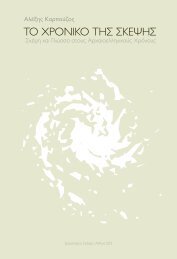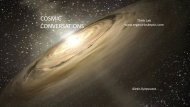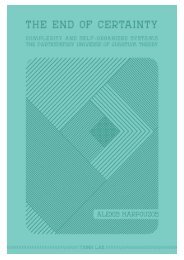COSMOLOGY, PHILOSOPHY AND PHYSICS -ALEXIS KARPOUZOS
The universe is not a world of separate things and events but is a cosmos that is connected, coherent, and bears a profound resemblance to the visions held in the earliest spiritual traditions in which the physical world and spiritual experience were both aspects of the same reality and man and the universe were one. The findings that justify this new vision of the underlying logic of the universe come from almost all of the empirical sciences: physics, cosmology, the life sciences, and consciousness research. They explain how interactions lead to interconnections that produce instantaneous and multifaceted coherence–what happens to one part also happens to the other parts, and hence to the system as a whole. The sense of sacred oneness experienced by our ancestors that was displaced by the unyielding material presumptions of modern science can be restored, and humanity can once again feel at home in the universe.
The universe is not a world of separate things and events but is a cosmos that is connected, coherent, and bears a profound resemblance to the visions held in the earliest spiritual traditions in which the physical world and spiritual experience were both aspects of the same reality and man and the universe were one. The findings that justify this new vision of the underlying logic of the universe come from almost all of the empirical sciences: physics, cosmology, the life sciences, and consciousness research. They explain how interactions lead to interconnections that produce instantaneous and multifaceted coherence–what happens to one part also happens to the other parts, and hence to the system as a whole. The sense of sacred oneness experienced by our ancestors that was displaced by the unyielding material presumptions of modern science can be restored, and humanity can once again feel at home in the universe.
Create successful ePaper yourself
Turn your PDF publications into a flip-book with our unique Google optimized e-Paper software.
space is a pictorial diagram in which an object is illustrated in the three dimensions<br />
of space depending on the time.<br />
At the “Copenhagen Interpretation” the equation does not depict reality; the equation<br />
is simply an algorithm, a mathematical method for creating statistical forecasts. For<br />
example, the result of the experiment with the cat will be a dead cat or a living cat.<br />
John Wheeler, a physicist from Princeton University considered that the term<br />
“observer” should be replaced by the term “participant”. A participant is someone<br />
who does not only observe one event, but he transforms it by the simple act of his<br />
observation. “Maybe the universe comes to a state of existence, in a weird manner,<br />
by the participation of those who participate. The vital act is that of the participation.”<br />
For Wheeler “subject” and “object” create one another. Sir James Jeans supported<br />
that the creator of the matter is, probably, the mind. Jack Sarfatti expressed the<br />
hypothesis that the “structure of matter, may not be independent of the<br />
consciousness”. For Eugene Wigner, the paradox of Schrodinger‟s cat takes place<br />
the very moment of the experiment when the human observation intervenes. He<br />
supported that the consciousness is the hidden variable that decides on the outcome<br />
of any event.<br />
During the 1950s, Hugh Everett expressed the theory of multiple universes. His<br />
interpretation supports that the universe is continuously divided into a surprising<br />
number of parallel realities. In such a universe, not only do we exist in an<br />
undetermined number of worlds, but also at the same universe all the possible<br />
outcomes of any incident are inherent. According to the theory of multiple universes,<br />
the universe is divided into an infinite number of universes, which come from the<br />
interactions of the thousands of its components. In that universe every quantum<br />
transformation that takes place in whichever star, of whichever galaxy or at<br />
whichever position at the universe, divides our earthy world into a myriad of<br />
imperfect copies of itself, which, however, ignore one another. In Schrodinger‟s<br />
experiment, the moment of the selection, when the observer opens the box, the<br />
universe is divided into two identical copies, identical in all details, apart from the fact<br />
that at the one the cat is dead and at the other it is alive. Both probabilities (cat dead<br />
and cat alive) are equally real but exist in different universes. Every cat that survives<br />
in our universe dies in another universe or vice versa. Everett‟s interpretation about<br />
5









